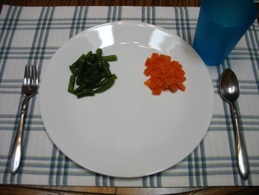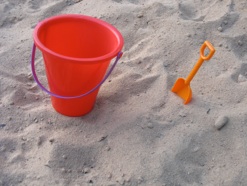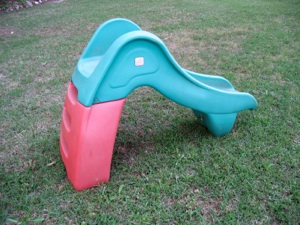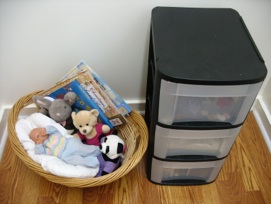-
1.Count.
Even young children can learn to count up to 3. Use counting up to 3 to encourage obedience, and let your child know she can’t ignore your command. For example, when you have told your child “Come,” but she shakes her head and stands her ground, begin counting slowly. If she doesn’t come by 3, walk over to her, pick her up and take her to the place you called for her to come. Your toddler will quickly learn that she has until you count to 3 to comply with the command. Count slowly when she dawdles and quickly when she responds quickly. If you tell her “Come,” don’t let her get away with ignoring this command or she will learn very quickly that she doesn’t have to listen.
-
2.Distract
If your toddler keeps complaining about how you tied his shoes, and is not satisfied even after you have retied them several times, use distraction. Point to a flower, or bug, or talk about the slide he can slide on when you get to the park. Silly dance, or make funny noises, changing what you do each time your child makes a noise as if you are a T.V. show, or radio show, and your child is changing the channels. Try to be creative, because what you do or say has to be surprising in order to distract. Pointing to something your child sees every day is not going to make him stop crying! If your toddler complains about being tired of walking, try running together, or have a race to the next telephone pole. You may laugh, but it works!
3. The rest of the house and garage
Look for and lock up medicines, toiletries, paints, cleansers, sharp objects, electrical equipment, breakable figurines and knick-nacks, blind cords, extension cords, tools, small objects that could be choked on (such as loose change or game pieces,) rat or roach poison, etc. etc. Cover electrical outlets with special plugs or clear tape. Test shelves and furniture to see whether they will tip over if your toddler tries to climb them. Look for for buckets or other containers that the child could fall head first into and not be able to get out--they can drown in only a couple of inches of water. Keep windows locked that they could open and fall out of. Don’t forget your purse--it could have medicine (aspirin , small or sharp objects (coins, nail file, etc,) or chemicals (hand creams, suntan lotion, insect repellent, etc.) Always stow it out of reach if you need to keep such items in your purse.
3. Give Choices
Don’t ask your child “Do you want to eat beans?”--that is just begging for trouble. What are you going to do when she says, “no”? Instead, ask her if she wants beans or carrots. Never ask your toddler if she wants to hold your hand to cross the street--you are giving her the option to cross a dangerous street without a safety restraint. Instead, give her a choice of holding your hand or being carried. If she pulls her hand away, or runs ahead, pick her up and carry her. She has chosen her own consequences. Don’t budge on this one--her life is at stake.
Don’t feel like you have to ALWAYS give your child choices and options, though. If children are always given choices for everything, they begin to think that they are entitled and will always be able to make choices, but life often offers only one option.
1. The kitchen and pantry
Keep knives, detergent and cleaning supplies in locked cupboards or out of reach (once they can climb, “out of reach” doesn’t work any more.) Keep the number for poison control near the phone, and keep a bottle of syrup of ipecac on hand incase you need to induce vomiting.
-
2.The bathroom and laundry
Keep medicines, toiletries, detergents and cleaning supplies in locked cupboards or out of reach (once they can climb, “out of reach” doesn’t work any more.)
Baby-proof, Baby-proof, Baby-proof your home.
If you don’t, you have to be super vigilant every minute of every day. Sounds exhausting, doesn’t it? Here is a partial list of places to check.
Strategies that encourage obedience in toddlers
Some people think this is the best time to make sure children learn how to obey. Instead of putting delicate objects out of reach, every time their child puts out his or her hand to explore a contraband object, they tell their child, “NO!” and slap the child’s hand or pop their bottom until the child stops putting out his or her hand to touch all the fascinating objects.
There are several difficulties with this method. First, it tends to inhibit curiosity--the main driving force for learning at this age. Second, this constant restraint of curiosity means that the parents and children have countless unpleasant encounters every day. Both child and parent are exhausted by the end of the day!
There is a much easier and more pleasant way to handle this. Why not just put all those objects out of reach, then let the child explore everything in reach. Instead of telling the child to sit down to eat 20+ times per meal, why not get a highchair so the child can’t walk around until the meal is over? Spend time playing with your toddler instead of constantly reprimanding. Fill the home with joy and warmth instead of restrictions. There is plenty of time to make obedience really work once they can understand the explanations!
If you choose this method, there is only need for a few rules for toddlers.
“Stop!”
“Come”
“Hot”
These sound like super simple commands, and they are. But it is REALLY important to make sure that when you say these words, your child obeys. I have seen so many parents let their young child run ahead on a quiet street, and as they approach a busy intersection, call, “Stop!” and do nothing as their toddler races toward possible death. Practice this command at home and in the yard. To begin teaching this word, everyone can silly dance, but as soon as Mom says, “stop” everyone freezes. A simple game like this is a great way to teach the meaning of the word “stop.” Next you have to teach the idea of stopping while you are walking. Walk around the house and randomly say “stop” and everyone freezes. Now take it outside to the yard or driveway to practice. Don’t let them walk without holding their hand on a street until they consistently and quickly obey this command. Their life could depend on it!! “Hot” is a much easier command to teach. Hold your child at a sink and turn on the cold water, put the child’s hand under the water, and say, “Cold.” Then turn on the hot water to a temperature that is uncomfortably hot, but not hot enough to hurt them. Put the child’s hand in this hot water, and say, “hot.” That is just about all you have to do for that. When your child is in the kitchen, point to the stove, and say “hot,” or say it when you put a hot dish on the table, and your child will steer clear of it!!
4. Outside and Garage
Look for holes they could fall into, or places their heads could get stuck. Lock up tools such as rakes or hoes. Move anything that could topple over on them when they pulled on it or climbed on it. If you have a fence, look for places a small child could squeeze through or get stuck. Look for buckets or other containers that the child could fall into and not be able to get out--they can drown in only a couple of inches of water. If you have a wading pool, be sure to empty it when you are not there, so that they don’t wander out and play in it unattended.
A few funny and cautionary tales
My first child was always at my side, so she only has a couple of stories. One day, all of a sudden I realized I heard water running and splashing, and since I wasn’t washing clothes, and my husband wasn’t taking a shower, this could not be good. I followed the sound and found water over an inch deep in the bathroom. In Japan, above the toilet tank is a faucet where you can wash your hands, then the water drains into the tank. (Pretty ingenious design, huh?) My daughter had climbed onto the toilet lid and played in the water, and had pulled the hand towel off the rack and left it plugging the drain. Since the tank had not filled, the water kept running over and slowly filling the bathroom floor! If I had not discovered it, the whole first floor could have been flooded! Another time, when I had used her second birthday as an excuse to invite neighbors over to get to know them, by the time the last guest went home, I was exhausted. Later I found a marker scribble on the wall--my 2 year old’s sentiment of the day’s event! I did not punish her for either of these incidents, but told her not to do it again...she never did.
My second child is the one with all the funny and scary stories. One day when we had come home from grocery shopping, I plopped my baby and bags of groceries on the floor. My oldest wanted help with something, and by the time I turned back to the task at hand, I discovered my baby sitting on the floor, having discovered an apple within reach, had eaten half of it with her 4 teeth! Another time she discovered a bug outside and put it in her mouth, but I saw it and pulled it back out. Another time, she found a sparkler that had fallen on the floor and bit the end off. If I had taken that end with me to the doctor’s office, maybe she wouldn’t have had to have her stomach pumped! Those are all in the safety of my “baby-proofed” home. It is even scarier to visit other people’s homes because they do not baby proof! When my second child was a year and a half, we went to stay with my husband’s parents. She sucked on some of her grandmother’s pills, but spit them back out. She took a taste of the shampoo. She came down the stairs saying “Ukky, mommy! Ukky!” It was even worse when we visited my dad. I found her sitting on the floor playing with rat poison she had discovered under the sink! When I called poison control, they guy just told me to watch for bruising! Thankfully she was fine. Later I discovered her on the wrong side of a banister of the second floor. It is amazing she survived to adulthood!
When my son was a toddler, I was busy getting ready for teaching a craft class when my oldest informed me that he was popping the vitamins as if they were candy. I grabbed him and got as much out of his mouth as I could. My husband dropped me off at the craft class and took our son to the doctor’s office. He did not get his stomach pumped, but probably should have, just to be safe, since the vitamins contained iron. He was fine, but later I was horrified when I heard what could have happened to him: when I told my sister about it--she told me that she knew of a toddler who had eaten pills containing iron right at the feet of his parents as they were reading their mail. Sadly, he went blind!
It is REALLY, REALLY important to baby-proof your home, and stay vigilant, and to be even more vigilant when visiting other people’s homes!!
Parenting > Discipline > Sample Rules for Toddlers
Parenting > Discipline > Sample Rules for Toddlers
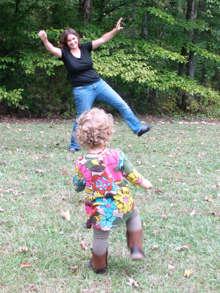


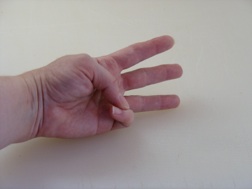

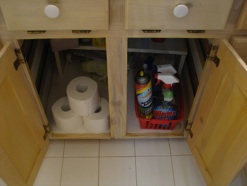

Replace dangerous items with things that encourage curiosity. I made sure everything in the lower kitchen cabinets and drawers were objects that my young child could play with--pots and pans with lids, unopened cans and boxes, dish towels and hot pads, etc. A container of flour became an indoor sandpile. Yes, it made a bit of a mess, but kept her busy for a long time while I cooked. Once she lost interest, I put away the container of flour and swept up the spilled bits--a small cost for uninterrupted supper preparation!

I kept bath toys in a net bag that fastened to the wall with suction cups. This included squirt bottles (empty dish soap bottle or ketchup bottle washed out and filled with water) floating toys, measuring cups and funnel, shapes to stick to the wall, etc.

What ever room you spend time in, have a box, basket, or drawer of toys for your toddler to discover and explore. Change these periodically so that there will be new toys and objects to study.












